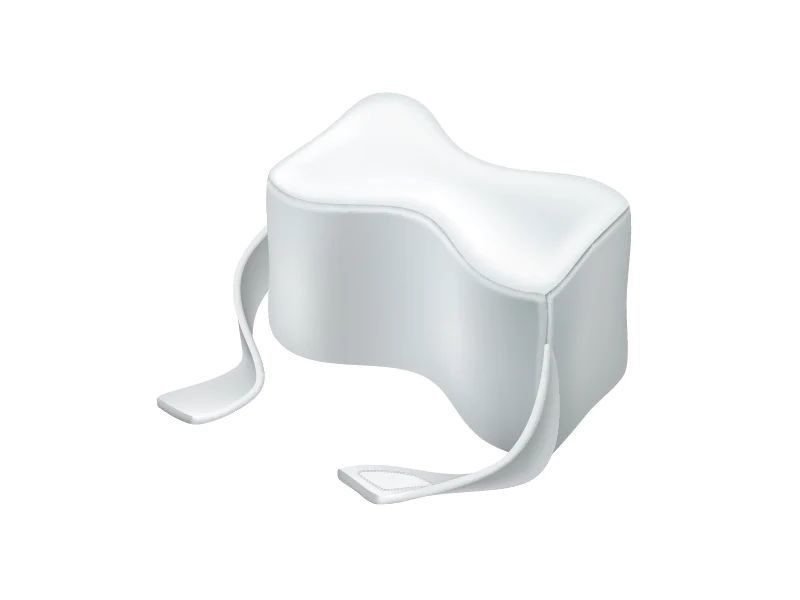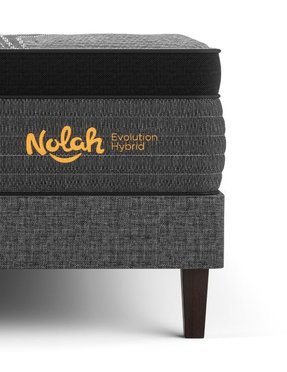What Type of Pillow Is Best for Side Sleepers?
How to Find the Best Pillow for Side Sleepers
While there isn't one "correct" sleep position, there is one that's far more popular than the rest: side sleeping. If you're among the 74 percent of adults in the U.S. who sleep on their side, you know how important it is to have the right pillow to feel comfortable. Paired with a best mattress for side sleepers, you'll have the perfect setup for rejuvenating rest.
While back sleepers can get away with thinner pillows and many stomach sleepers don't use pillows at all, side sleepers require a pillow with structure and loft to support their head and neck. Plus, a lot of side sleepers can’t get comfortable without a for their knees as well.
In this guide, we'll dive into the unique needs of people who sleep on their side and identify which pillow types and materials can deliver on these specifications.
The Anatomy of a Side Sleeper
Whether you sleep on your left or right, side sleeping puts the most pressure on your knees, hips, and shoulder. Without a supportive pillow and a best mattress for side sleepers with back pain, these pressure points can sink into the bed and cause spinal misalignment and soreness.
Side sleeping also leaves your head in a precarious position. Due to the broadness of your shoulders and the weight of your head, sleeping on your side causes your neck to slope downward if you have a thin pillow or no pillow to support it.
Sleeping with a pillow that's too thick or firm forces your neck to bend in the opposite direction. Straining your neck muscles for the entire night can cause soreness, stiffness, or even severe pain.
The side sleeping position also stacks one leg on top of the other, and the weight of the upper leg and bulkiness of the upper kneecap can put undue stress on the bottom leg and knee. Your upper hip is also likely to rotate toward the surface of your mattress, which pushes the spine out of line.
What Side Sleepers Need From Their Pillow
Just as with back sleeping and stomach sleeping, the side sleeping position leaves some vulnerabilities. That said, your pillow choice can account for the stress the position puts on the body, helping you sleep in total comfort. When shopping for a new pillow, side sleepers should consider all of the following characteristics.
Struggle with stress on your shoulders at night? Check out our guide How to Sleep on Your Side Without Hurting Your Shoulders.
Loft
Head Pillows
Side sleepers need a pillow that's just the right height to keep their head and neck supported. While a pillow that's too thick bends the neck upward, one that's too thin lets the head dangle and pulls the neck down toward the bed.
In the pillow industry, loft refers to the height of the pillow when compressed. This term accounts for both the pillow's thickness and the density of the material. While denser pillow infill resists pressure, supports the head, and maintains most of its height, less dense filling falls flat under your weight.
Your ideal pillow loft depends on the width of your shoulders, or more specifically, how far the base of your neck rises above your mattress when you sleep with one shoulder against the bed.
The key to comfortable side sleeping is to find a pillow with the right combination of thickness and density. The pillow should keep your neck suspended above your mattress at the same height as your spine. For most side sleepers, that means a pillow around 5 to 6 inches thick.
Knee Pillows
Sleeping with a pillow between your knees has a number of health benefits, including improving blood circulation and enforcing spinal alignment. Side sleepers should look for a small pillow that fits comfortably between your knees when you lay with your legs curled slightly toward your chest.
To maintain neutral spine alignment, you need a pillow with enough loft to prevent your hips from rotating when you stack one leg on top of the other. The pillow also has to be tall enough to keep your kneecaps from knocking against one another. For the majority of side sleepers, a knee pillow between 4 and 6 inches thick does the trick.
Support and Pressure Relief
Pillows should be more than just soft and comfortable—to promote healthy sleep, they also have to provide structure.
Working together, your mattress and pillow should keep your entire body aligned in a neutral position. For side sleepers, a pillow's job is to fill in the space between the mattress and the base of your neck to keep your neck in line with your spine. A side sleeper pillow should also disperse the pressure that the position puts on the side of your face and ear.
How much support and pressure relief a pillow provides all depends on the infill's density. You can head over to our Pillow Material Guide to learn about your many options.
For side sleepers, a pillow's job is to fill in the space between the mattress and the base of your neck to keep your neck in line with your spine.
Contouring
Regardless of your sleep position, you want a pillow with just enough "give" to cradle your head and neck. However, you don't want a pillow that's too flexible, or it will compress under your weight and allow your neck to fall out of alignment.
When shopping for a new pillow, side sleepers should look for gentle contouring. Pillows with light contouring follow the curvature of your head and neck and provide cushioning but still keep them properly elevated. They're flexible but not so malleable that they completely conform under pressure.
Responsiveness
Responsiveness refers to how quickly your pillow or mattress reacts to pressure and pressure removal. For example, latex pillows are very responsive and immediately bounce back when you lift your head. On the other hand, memory foam responds slowly and maintains its shape for a while after you remove or shift your weight.
Side sleepers don't typically have specified needs when it comes to responsiveness. However, if you tend to move around a lot in your sleep, you'll want a pillow that quickly readjusts as you reposition your head and neck. Latex pillows are known for their responsiveness.
Cooling
While not unique to people who sleep on their side, having a cooling pillow is a top priority for many sleepers. While some materials trap the heat that your body naturally gives off as you sleep, others allow air circulation that dissipates heat.
Again, you can head over to our Pillow Material Guide for more details. You'll also want to opt for a breathable, moisture-wicking pillowcase for optimum temperature control as well as a best mattress for hot side sleepers.
Looking for more ways to sleep cool? Check out our article on the best mattress for hot side sleepers.
3 Pillows Perfect for Side Sleepers
With the particular needs of side sleepers in mind, we've composed a list of pillow types that check off all the boxes. You can use the descriptions below to find a pillow that works for side sleeping as well as your specific condition-based concerns.
1. The Best Pillow for Side Sleepers with Neck Pain
Sleeping incorrectly, poor posture, repetitive motion, and impact injuries can all cause neck pain that makes it difficult to fall asleep. Even if your pillow isn't the original source of the soreness or pain, sleeping on the wrong pillow can add further strain, prevent proper healing, or agitate an old injury.
If you experience chronic pain or severe neck trauma, such as a car accident or sports injury, you should see a health professional as soon as possible. For those with duller neck pain or general soreness, switching pillows may make a world of difference.
For side sleepers with neck pain, we recommend an adjustable model like our Adjustable Shredded Foam Pillow. With a two-chamber design and removable shredded foam infill, it lets you add or subtract stuffing until you find the perfect height and support level. Plus, the foam filling provides subtle contouring. The pillow's breathable cover and loose infill design also allow maximum airflow for cooling relief.
2. The Best Pillow for Side Sleepers with Knee Pain
Side sleepers with knee pain often benefit from an orthopedic knee pillow. These small and uniquely shaped pillows serve two key purposes: they enforce hip and spinal alignment and provide pressure relief to your knees and legs.
Many side-sleeper knee pillows have a similar shape to the one shown below, sometimes referred to as a "knee T" design. Sleepers can position the pillow between their legs, either at their thighs or the top of their shins.

Hugging a pillow between your stacked legs stabilizes your body in a neutral position. For example, if you sleep with your left side against the mattress, the pillow prevents your right hip from rotating toward the bed.
A knee pillow with the right height and firmness will keep your hips parallel to one another, keeping your back straight and preventing undue stress on your legs and pelvis.
T-shaped knee pillows also separate your legs so your knees don’t knock together. Meanwhile, the two "wings" on the sides of the T cradle and cushion your legs and knee joints. Placing a pillow between your legs also creates a surface to disperse the weight of the leg stacked on top.
For maximum stability, support, and pressure relief, side sleepers should look for a contouring orthopedic knee pillow made with a dense but pliable foam.

3. The Best Pillow for Side Sleepers Who Snore
People who snore often benefit from wedge pillows strategically shaped to elevate your head above your chest and open your airways. Wedge pillows also keep your back straight, making them one of the best pillows for side and back sleepers alike.
However, side sleepers often don't know what to do with their lower arm when using a wedge pillow. To solve this problem, some companies sell wedge pillows with armhole cutouts or indentations.
As with orthopedic and adjustable pillows, you'll want a wedge pillow made with a contouring foam that doesn't trap heat or sink too far under your weight.
A Pillow That's On Your Side
Remember—every sleep position has its benefits and vulnerabilities. If you understand how side sleeping impacts your body, you can find a pillow that offsets the pressure, keeps your neck and spine in line, and provides support where needed most.
With the right below under your head or between your knees, side sleepers can find a neutral position that minimizes stress and lets you drift to sleep pain-free.
Disclaimer: Nolah does not provide medical advice. All resources on the Nolah blog, including this article, are informational only and do not replace professional medical counsel. Talk to your doctor about any health, mental health, or sleep-related issues.
You May Also Like These Articles
Don't Sleep on Exclusive Offers
Sign up for our newsletter, and you'll be the first to know about discounts, deals, and what's new at Nolah.
Ready for Bed?
